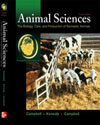
Breeds and Life Cycles of Livestock and Poultry |  |
Chapter Summary| Breeds of livestock and poultry have been developed, for the most part, to assure increased efficiency in producing meat, milk, eggs, and wool for humans. Exceptions include the development of certain breeds of chickens for game purposes and horses for the track and pleasure riding.
In this chapter we learned how breeds are developed for specific form and functions, how they may differ genetically, and why there are different breeds. The major breeds and life cycles of selected livestock and poultry of North America were noted. Collectively they provide animal products for humanity—the foremost function of animal agriculture in the United States.
The livestock industry underwent massive change during the twentieth century—a century that began with animals providing the majority of farm and ranch power. Needs for rendered fat as well as consumer preferences resulted in slaughter livestock with heavy fat cover and low efficiency in converting feed to body weight gain. Pure breeds of livestock and poultry were predominant in production systems. In the last third of the twentieth century dramatic changes occurred in types of livestock produced in the developed nations. By midcentury the tractor hastened the agricultural production revolution by becoming the primary source of farm power. Consumer preferences dominated changes in later years by demanding leaner meats and lower fat animal products. Changes in livestock type and production efficiency were accomplished by adjustments in breeding and nutrition management programs. Different breeds became popular, and crossbreeding became a dominant force in commercial animal production. Farmers and ranchers continue to respond to the preferences and needs of consumers as animal agriculture positions itself to provide desired and much needed, as well as competitively priced and safe, animal products in the twenty-first century.
The stage is now set to learn more about the availability, nutritional contributions, and food safety aspects related to animal products for humans in Chapter 3.
|
|
|